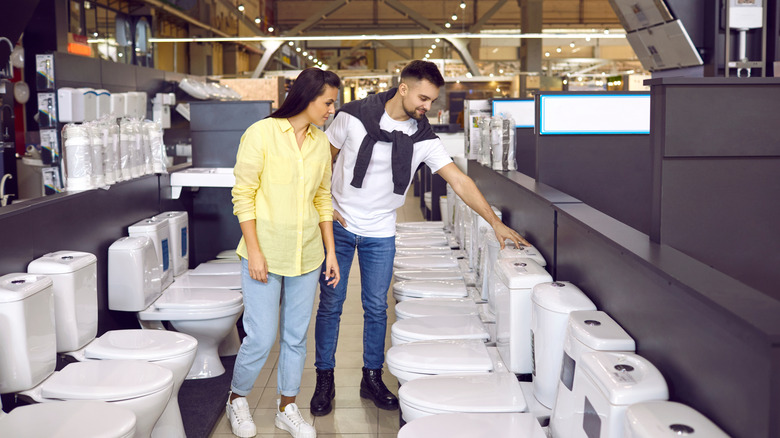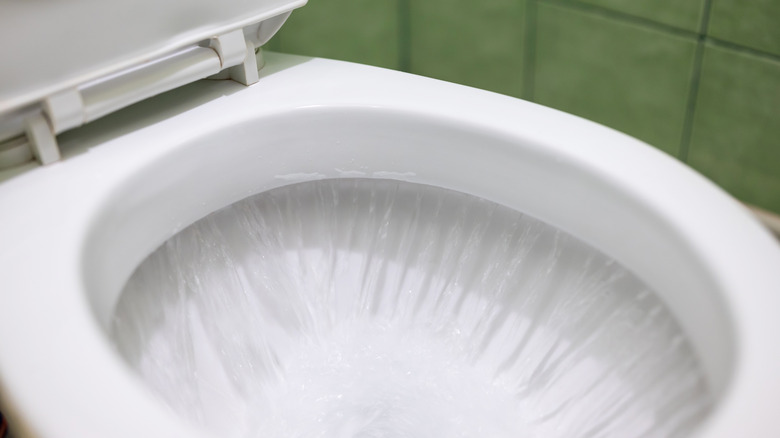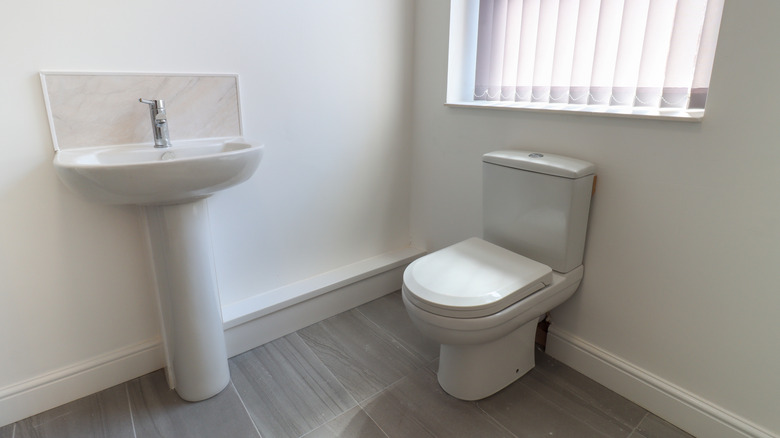What To Know Before Buying And Installing A High-Efficiency Toilet
Could saving the planet start with a single flush? That may be a bit much to ask of a humble toilet, but these days, high-efficiency toilets are becoming the norm. Mandated by federal law since the early 1990s, the fixtures are designed to flush with way less water. According to the U.S. Environmental Protection Agency, replacing your old porcelain throne with a newer model can reduce your overall water use by up to 60%. In other words, both your wallet and the planet will thank you. Eduardo Linares, virtual plumbing expert at Frontdoor, agreed that using a high-efficiency toilet uses way less water but cautioned that you should carefully consider potential costs and clogs before buying and installing one.
"High-efficiency [HE] toilets are toilets that use less water to remove solids and liquids from the bowl through different means, depending on the manufacturer of the toilet," Linares told House Digest during an exclusive interview. The plumbing expert said they basically work like any other toilet. "Generally, HE toilets use approximately 1.28 gallons of water per flush," he explained. Once you start toilet shopping, you'll quickly find a variety of water-saving styles to choose from. According to Linares, "Dual flush toilets, which are toilets with separate functions for liquid and solid waste removal, tend to use 0.8 GPF [gallons per flush] and 1.28 GPF for solids." With so many options out there, he added that it's crucial to do your research and pick the potty that's best for your particular needs.
Pros and cons of high-efficiency toilets
A low-flow toilet may not be a worthwhile addition, especially if you have an older home or several bathrooms that will require replacements. But high-efficiency toilets are typically designed to save you money and still do most of the dirty work for you. "The main benefit of purchasing an HE toilet is lower water consumption," Eduardo Linares said during his exclusive interview with House Digest. "HE toilets can use as little as 1.28 GPF ... as opposed to a low-flow toilet, which uses around 1.6 GPF," he explained. The difference between the two types of water-saving toilets is less than half a gallon of water, while older toilets often used three or four times as much. Still, installing either one of the eco-friendly fixtures is about more than just saving on your water bill. "Using less water can also have environmental benefits."
However, high-efficiency toilets are only terrific until they're not. According to Linares, their biggest advantage — those water savings — is also their biggest disadvantage. "The use of less water to flush solids could mean more frequent clogging of the toilet and having to flush the toilet multiple times to clear waste from the bowl." He added that this can cause a huge hassle if you have an older plumbing system. "Using less water to push solids through the pipes could cause branch and stack line clogs in the plumbing system, which can become costly to remedy."
How to choose and install a high-efficiency toilet
How do you know if a high-efficiency toilet is a good choice for your home? "If you live in an area that has water restrictions, an HE toilet — specifically a dual-flush toilet — could be a good option if you are looking to replace your current toilets, or if you are just trying to lower your water bill," Eduardo Linares told House Digest during his exclusive interview. Remember to check your local regulations, plumbing codes, and water efficiency standards before making your decision. You should consider the overall age of your home's plumbing, too. If you have a home with older cast iron or galvanized piping, Linares said a high-efficiency toilet may not be the best option. Instead, the plumbing expert suggested considering a low-flow toilet, because "an HE toilet may not have sufficient water to push the toilet paper and solids through older piping."
Installing any toilet is one of the plumbing projects you should leave to the professionals. But according to Linares, the process is pretty standard no matter which type of toilet you choose. "The most common method is floor-mounted, which is where the toilet bowl bolts to a flange on the floor that is connected to the waste pipe," he explained. High-efficiency, low-flow, and standard toilets are available in skirted and non-skirted models. Linares recommended picking out a skirted model that hides the hardware, offering a more attractive look that's also easier to clean.


